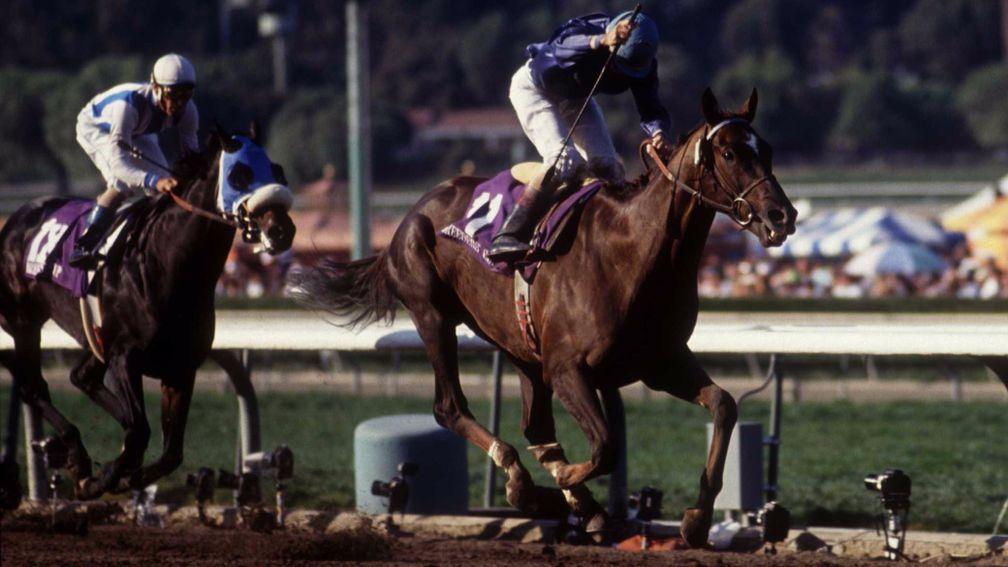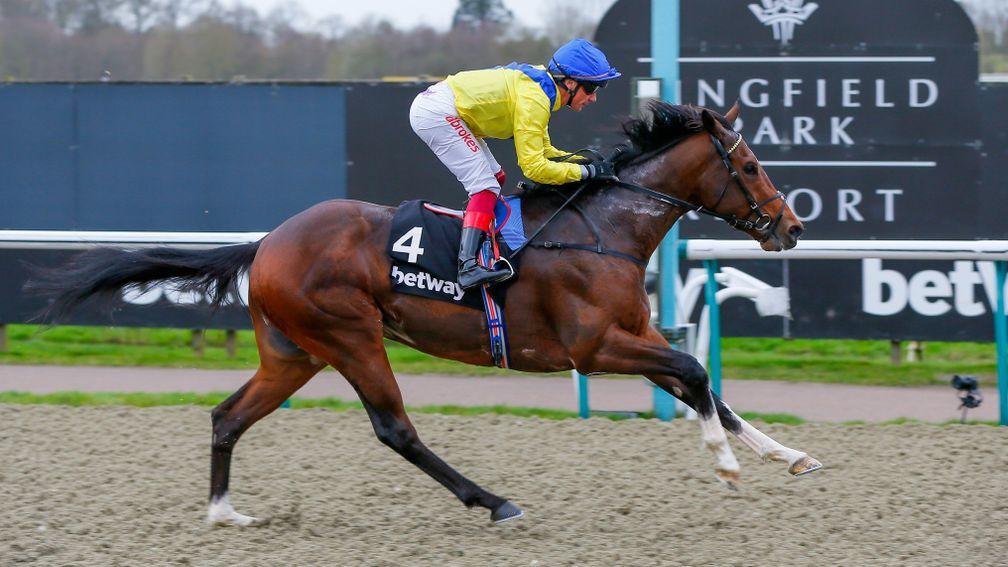Why the all-weather is the perfect betting medium for the discerning punter

I've been an avid follower of all-weather racing for as long as I can remember and focus the majority of my betting on it. It has given me my biggest-priced winner in Arcangues, who landed the 1993 Breeders' Cup Classic at odds of 133-1, and more recently my biggest win, thanks to a treble that ran into five figures.
The main reason it appeals more than turf as a betting medium is because you are dealing with a smaller pool of runners, with fewer unknown quantities, and the same horses often race against each other every week on similar surfaces.
That cuts down the amount of time you have to spend on studying form and watching replays, especially as you become familiar with certain runners who turn out regularly. This is still valid, despite the addition to the roster of Newcastle, a track that attracts big fields at each meeting.

Replays
It's hard to comprehend nowadays that not much longer than a generation ago most gambling was done blind, so to speak. There was certainly no access to replays for the vast majority of punters when I started betting seriously in the early 1990s. Those who could afford to subscribe to the old SIS were at a huge advantage, along with anyone able to spend every day at the track or in the bookies watching the racing. Back then I tended to use speed figures in an attempt to get an edge on those who perhaps just studied the form in the paper, but nothing can come close to actually watching a race.
I know I'm at an advantage by working in the industry. However, it takes me not much more than an hour to go through a week's worth of replays. That's doable in anyone's book, surely.
The downside is that the more people who have access to replays and are disciplined enough to spend the time analysing them, the less chance you have of spotting something that someone else hasn't seen.
Still, it's obviously where you have to start, and then everything else should lead off it.

Lower-class races
I am attracted to lower-class races, and there are plenty of them. The main reason – and this is admittedly a bit of a generalisation – is because horses in the 45-70 range find it difficult to maintain their form and there are significantly fewer progressive runners lower down the food chain (the lower you go the harder it is for them to put two similar performances together).
So, in theory, a last-time-out winner is often worth taking on, especially if it had a smooth passage. This is handy from a punting perspective because horses with 1s next to their name tend to be supported in the betting more than those without, meaning the value will probably lie elsewhere and at a bigger price.
Excuses and something different
There are two types of horse I tend to look for when tipping and gambling.
Firstly, they had a valid excuse on at least one of their last two starts – and preferably both. Along with an unfavourable draw, excuses could include poor track position, a slow start or getting hampered. However, having one (or more) excuse in itself is usually not enough to justify backing a horse. Ideally, I want the runner in question to have still shown something. For example, it rallied strongly after being hampered or was still in contention approaching the final furlong after racing without cover throughout.
There's a danger of being sucked into backing any horse who is hampered out the back when seemingly going well, but there are so many of them on the all-weather that it's unlikely even half are unlucky.
In a similar vein, runners who stay on strongly in the home straight can be rather eyecatching – particularly up the short one at Lingfield – and are often considered unfortunate. Be careful with this type as more often than not it's a case of the pace collapsing in front. In fact I pretty much ignore exposed or older runners who seemingly motor through the final furlong. There are exceptions, though, which brings me to the pace angle excuse and this is one that I look for at any level of racing.
There is enough free information out there to make this a science rather than an art nowadays, although sometimes all you need are your eyes. If a runner is alone in making up ground from the rear in a race that clearly favoured those who raced prominently, then I will take note. Likewise, if one manages to stay on after racing near or at the head of affairs while the rest of the prominent racers drop away, that horse will probably go in my tracker.
I say 'probably' as there could be other factors at work. For instance, you could find a runner in stall one stays on much better than a runner from stall 12 after they duelled for the lead. The runner from stall 12 may have had to use significant energy to get across from a wide draw, unlike the runner on the rail in one.
There was no better example of how important pace is in a race than in the 2020 Winter Derby at Lingfield, when Frankie Dettori was allowed to do his own thing in front on Dubai Warrior and never saw another horse.
Bangkok was all the rage having smashed the course record in the trial, finishing more than four lengths clear of Court House. However, he'd clearly benefited from an end-to-end gallop that day and Dettori was wise to it, dawdling through the early stages before winding things up. After refusing to settle early on, the favourite had little in the tank in the home straight.

Bangkok covered the course in 2min 0.54sec in the trial and finished the race well, the strong early fractions clearly helping him to run to what was probably the peak of his ability; Dubai Warrior stopped the clock at 2min 1.64 sec in the Derby yet Bangkok was unable to even get past Court House in the home straight.
The other type of horse I tend to back is one who is doing something different, often after running moderately on its latest start. For example, it could be stepping up or down in trip, switching from Tapeta to Polytrack or from turf to Tapeta, or returning from a break. You get the gist. Also, more subtly, it could be a runner who was asked to race in a manner it was unaccustomed to last time (like forcing the pace when usually held up or vice-versa).
They say a change is as good as a rest and I find it can often lead to an improved performance. For instance, expecting an exposed five-year-old to suddenly show something more over 6f after racing exclusively at the trip for a few weeks reminds me of Einstein's definition of insanity, regardless of the fact its handicap mark may have dropped to a potentially dangerous level. However, ask it to go a stride more quickly or slowly over a shorter or longer trip and you may have a chance of sparking a revival.
The draw
Understandably, a lot of emphasis is placed on the final stages of a race when it comes to analysis. I've always thought, though, that the first couple of furlongs can be equally as important when it comes to the all-weather.
Leaving Newcastle aside and the 5f course at Southwell, every race is run around at least one bend and the first one often looms up soon after the start (think 7f contests at Wolverhampton), so bagging a decent position is not only often crucial, it can be extremely difficult from a high draw in big fields.
Even in races over further, it regularly takes runners drawn wide a couple of furlongs to tack across and settle into a position – and that's when they don't get stuck on the outside of the field without cover.
While it's impossible to quantify just how much extra ground a horse has to cover from a high draw, it's hardly rocket science to say it's much more preferable to come out of the stalls maintaining a straight line and immediately settling into a rhythm rather than having to switch left or right and go looking for cover. And that's not taking into account the extra energy a horse may have to use in doing so.
An example of such a runner I've backed is Traveller, who failed to find cover from stall 11 when a well-beaten ninth at Wolverhampton. Although I would have normally liked to see more before placing a bet, the fact he'd won his previous start was reason enough for me to give him another chance when he returned to Dunstall Park and he got up close home after being backed into 7-2.
Pietro Innocenzi Q&A
What was your first bet?
£1 win on Corbiere in the 1983 Grand National. It all seemed so easy as a schoolkid but Little Polveir in 1989 is the only National winner I've backed since!
What was your biggest win?
A few quid short of £15,000 thanks to three doubles and a treble on some bog-standard all-weather racing in 2015 (taking early prices the evening before boosted the winnings somewhat).
What was your most painful loser?
Forpadydeplasterer finishing fourth in the 2008 Ballymore. Master Minded and Katchit had landed the first two legs of doubles and a treble and I stood to win £39,000. That was slightly more hurtful than the time I was part of a syndicate that blew out in the final leg of a Jackpot despite having the first three in the betting in our perm. That would have been well into five figures too.
What was the best punting advice you’ve received?
There's no room for sentiment.
Course guide by David Bellingham
When all-weather racing in Britain started, it was suggested that you couldn't rely on turf form being transferred to artificial surfaces, but I would also now argue that you can't rely on all-weather form being replicated between tracks with the same surface.
Being right-handed, Kempton Polytrack form may not work out at Lingfield, Chelmsford or Dundalk; horses may enjoy the Newcastle Tapeta but not show similar form at Wolverhampton. Some can produce their best at more than one track, but I would give priority to form shown at the same venue first.
Chelmsford is a specialists' track and it does appear to be a disadvantage to stick to the inside rail in the home straight. Often the runners fan wide on turning in with the main action unfolding down the centre. In races from 5f to 1m a low draw and prominent early position are an advantage.
At Dundalk there isn't a major draw bias, but a prominent early pitch is an advantage over 5f to 1m whereas it's tough for front-runners over 1m2f-plus.
Kempton has two tracks, the inner for races over 5f and 1m2f and the outer for all other trips. There isn't a draw bias over 5f but early speed is key, while from 6f to 1m a low draw and prominent early position are positives and also over 1m3f, where the first bend comes up quickly.
It's worth keeping an eye out for a track bias, as at some meetings switching to the inside rail after the cutaway can be an advantage whereas at others the opposite is true. Kempton is a track for specialists with some horses clearly suited by going right-handed.
At Lingfield one place you don't usually want to be is against the inside rail in the home straight, so the performance of any horse who either wins or goes close having taken that route can be marked up. Over 5f to 7f a prominent position is an advantage, but the only distance with a notable draw bias is 1m2f where a low berth is vital.
Newcastle has a straight mile on which there is no draw bias at any trip. Front-runners have a good record over 5f, but over 1m4f and 2m they have a hard time of it. Again, Newcastle is a track for specialists.
At Wolverhampton, a low draw and prominent early position are an advantage over 5f and 6f, but it's difficult for front-runners in races over 1m4f-plus.
Members' Club subscribers can read more from our Betting Masterclasses series:
Making it pay all over the world: the intricacies of the international scene
It's all in the breeding: the most underrated weapon in a punter's armoury
A winning system: using data to your advantage in the battle with the bookies
Still great value on the exchanges - you just might have to work a bit harder
James Willoughby: why speed is of the essence when rating horses
Betting for a living: a pro punter's insight on how to make gambling pay
Why there's never been a better time to be a serious student of the form book

Sign up here. New customers only. First single & e/w bet only. Odds of 1/1 or greater. 4 x £5 bet tokens. Free bet stakes not included in returns. Free bets exclude virtuals. Free bets are non withdrawable. No free bet expiry. Eligibility restrictions. Further T&Cs apply. 18+. begambleaware.org.
Published on 20 July 2021inBetting Masterclasses
Last updated 15:13, 10 December 2022
- Long-range punting: how to make the most of the odds on offer months in advance
- A numbers game: how to use Racing Post Ratings to improve your betting
- It's all in the breeding: the most underrated weapon in a punter's armoury
- Four experts on the art of being selective when it comes to betting
- Still great value on the exchanges - you just might have to work a bit harder
- Long-range punting: how to make the most of the odds on offer months in advance
- A numbers game: how to use Racing Post Ratings to improve your betting
- It's all in the breeding: the most underrated weapon in a punter's armoury
- Four experts on the art of being selective when it comes to betting
- Still great value on the exchanges - you just might have to work a bit harder